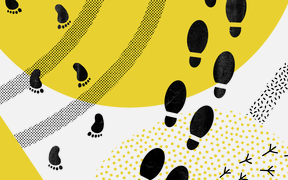What is it like to walk in Heidi Henrickson’s shoes?
My work in the Aalto Networking Platform involves bringing people together, so I don’t sit in just one building on a given day. This means I walk 10 000 to 12 000 steps meeting people in three different buildings: at the end of Vuorimiehentie, Dipoli, and Väre. With little time between meetings, in addition to comfortable shoes, I need the ability to pack up the computer fast, take my tea with me, and go!
Luckily my time in high school marching band playing the alto saxophone is still valuable today. If you look at how I walk, you can still see some evidence of marching band there: we roll our feet to make the walking softer, and the distance between the steps is very precise.
What do you think is the optimal way of doing teamwork?
Optimal teamwork starts with identifying what we want the outcomes to be. Then we turn to the stakeholders, the people who would be affected. Good teamwork is understanding this: what is the problem and what are the goals, but also identifying that every team member has a completely different way of approaching it. Each person has different skills and thinking, and we should let them shine.
Why is networking important to you?
Knowing other people and what they do at Aalto makes it easier for me to work efficiently and be effective at what I do. Do I know anyone who has the required skillset? Also, offering solutions to people just feels good.
Getting or staying connected with people at work is an important part of my personal well-being. Being connected helps me feel good about work and to be recognized for that work. Then I might have the focus and energy to say to the person next to me: ‘you did a great job, that was a nice presentation, your ideas are really inspiring, or that was a really strong argument’.
What do you think is the most effective way to create cross-disciplinary cooperation?
We’ve been promoting cross-disciplinarity top-down and bottom-up already, and throwing €30K at a project is a good way to get it off the ground, to combine projects or change the way we work together. But what if we could come in sideways? What can happen when you work across disciplines by rethinking your assumptions or the starting and end points?
For example, when you try to approach a challenge, you could throw away the idea that X has been done before. In BATCircle, for instance, they crushed old batteries and reused valuable components in new ones. Now, they are side-stepping some of the refinement altogether and are finding non-destructive ways to recycle. I guess that’s sideways thinking. Rather than making something more efficient, let’s just crush the materials and reuse them or stimulate them another way entirely.








